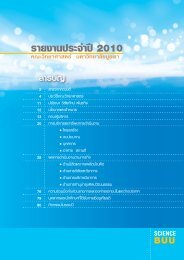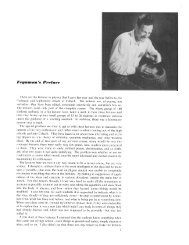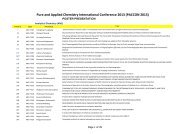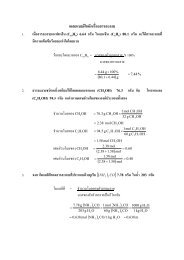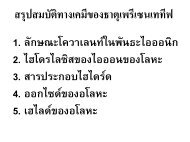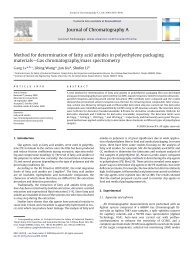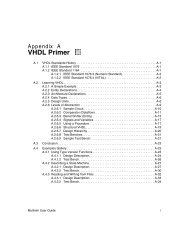USER MANUAL SWAN Cycle III version 40.72A
USER MANUAL SWAN Cycle III version 40.72A
USER MANUAL SWAN Cycle III version 40.72A
You also want an ePaper? Increase the reach of your titles
YUMPU automatically turns print PDFs into web optimized ePapers that Google loves.
12 Chapter 2<br />
that they do not affect the computational results there. This is best established by varying<br />
the location of these boundaries and inspect the effect on the results. Sometimes the waves<br />
at these boundaries can be estimated with a certain degree of reliability. This is the case if<br />
(a) results of another model run are available (nested computations) or, (b) observations<br />
are available. If model results are available along the boundaries of the computational<br />
spatial grid, they are usually from a coarser resolution than the computational spatial grid<br />
under consideration. This implies that this coarseness of the boundary propagates into<br />
the computational grid. The problem is therefore essentially the same as if no waves are<br />
assumed along the boundary except that now the error may be more acceptable (or the<br />
boundaries are permitted to be closer to the area of interest). If observations are available,<br />
they can be used as input at the boundaries. However, this usually covers only part of the<br />
boundaries so that the rest of the boundaries suffer from the same error as above.<br />
A special case occurs near the coast. Here it is often possible to identify an up-wave<br />
boundary (with proper wave information) and two lateral boundaries (with no or partial<br />
wave information). The affected areas with errors are typically regions with the apex<br />
at the corners of the water boundary with wave information, spreading towards shore at<br />
an angle of 30 o to 45 o for wind sea conditions to either side of the imposed mean wave<br />
direction (less for swell conditions; the angle is essentially the one-sided width of the<br />
directional distribution of wave energy). For propagation of short crested waves (wind sea<br />
condtions) an example is given in Figure 2.1. For this reason the lateral boundaries should<br />
be sufficiently far away from the area of interest to avoid the propagation of this error<br />
into this area. Such problems do not occur if the lateral boundaries contain proper wave<br />
information over their entire length e.g. obtained from a previous <strong>SWAN</strong> computation or<br />
if the lateral boundaries are coast.<br />
When output is requested along a boundary of the computational grid, it may occur that<br />
this output differs from the boundary conditions that are imposed by the user. The reason<br />
is that <strong>SWAN</strong> accepts only the user-imposed incoming wave components and that it replaces<br />
the user-imposed outgoing wave components with computed outgoing components<br />
(propagating to the boundary from the interior region). This is only the case for structured<br />
grids (both regular and curvi-linear ones). The user is informed by means of<br />
a warning in the output when the computed significant wave height differs more than 10%,<br />
say (10% is default), from the user-imposed significant wave height (command BOUND...).<br />
The actual value of this difference can be set by the user (see the SET command). Note<br />
that this warning will not apply in the case of unstructured grids.<br />
If the computational grid extends outside the input grid, the reader is referred to Section<br />
2.6 to find the assumptions of <strong>SWAN</strong> on depth, current, water level, wind, bottom<br />
friction in the non-overlapping area.<br />
The spatial resolution of the computational grid should be sufficient to resolve relevant<br />
details of the wave field. Usually a good choice is to take the resolution of the computational<br />
grid approximately equal to that of the bottom or current grid. If necessary, an





